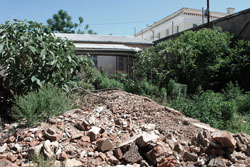Seminar: The Bungha Building as a Site for the Contestation of History
During the setting up of apartheid South Africa’s native reserves, or homelands, large-scale subsidies allowed the formation of ten separate states, with concomitant government offices, schools, hospitals, housing for relocation after forced removals, factory parks, hotels and sports centres. When apartheid ended, some of these buildings were incorporated into the functioning of the new South African provinces, whilst others were allowed to fall into ruin. Brenton Maart’s current research is investigating these architectural structures in a bid to read, within their histories, the signs of inadvertent monumentalization.
In this presentation, Maart discusses the Bungha Building as one of his case studies. Initially built to house the seat of the Transkei colonial administration, the building later became the government centre of the apartheid Transkei, also housing the homeland’s archives. When the Bungha Building was reassigned as the new home of the Nelson Mandela Museum, the archives were moved into a wholly inadequate space alongside, where the contents continue to rapidly disintegrate into tatters and ruins. This seminar analyzes the different lives of this building in relation to the shifting and conflicting politics and policies of bureaucracy and memory.

Mthatha Archive, 2012, photograph by Brenton Maart
To locate the Mthatha archive, visitors walk through a local healthcare clinic, negotiate the queues to the office to register circumcision practitioners and patients, skirt past head-height weeds and pick their way over a demolition site. The entrance is through the security gate. Behind the archive is the Bungha Building, the repository’s previous home but now the premises of the Nelson Mandela Museum.

